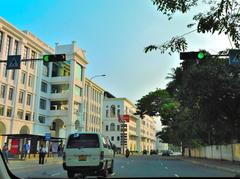Visiting St. Anthony’s Church: Hours, Tickets, and History
Date: 18/07/2024
Introduction
Table of Contents
- Introduction
- Early Beginnings - A Humble Start
- A Growing Community, A Growing Church
- The Transformation - Embracing Architectural Grandeur
- Architectural Influences - A Blend of Styles
- Notable Features - Symbols of Faith and Beauty
- Visitor Information - Plan Your Visit
- Special Events and Guided Tours
- FAQ
- Conclusion
Early Beginnings - A Humble Start
The church’s roots trace back to the early 20th century, a period when Wattala was a modest fishing village. Recognizing the spiritual needs of the growing Catholic community, a small prayer room dedicated to St. Anthony was established in 1910. This humble structure served as the nucleus for what would later become a prominent landmark.
A Growing Community, A Growing Church
As the congregation expanded, so did the need for a larger place of worship. In 1922, under the guidance of Rev. Fr. Maurice, the construction of a more substantial church began. This new edifice, though modest in comparison to the present structure, marked a significant step forward for the community.
The Transformation - Embracing Architectural Grandeur
The church we see today is largely attributed to the vision of Rev. Fr. S. Sylvester. His tenure, beginning in 1954, ushered in an era of remarkable transformation. Recognizing the need for a larger, more awe-inspiring space, he spearheaded the expansion and renovation of the church.
Architectural Influences - A Blend of Styles
The architectural style of St. Anthony’s Church reflects a harmonious blend of influences. While predominantly adhering to the Gothic Revival style popular in the early 20th century, it also incorporates elements of local Sri Lankan architecture.
Gothic Revival - Reaching for the Heavens
The Gothic Revival style, originating in Europe, is characterized by its emphasis on verticality and grandeur. This is evident in the church’s soaring arches, pointed windows, and the prominent spire that pierces the sky. These elements create a sense of awe and draw the viewer’s gaze upwards, symbolizing the aspiration to reach the divine.
Local Influences - A Sri Lankan Touch
While the overall design echoes European styles, the church seamlessly integrates elements of Sri Lankan architecture. The use of warm, earthy tones in the facade, reminiscent of traditional Sri Lankan temples, grounds the structure within its local context. This fusion of styles creates a unique architectural vocabulary that speaks to the church’s multicultural heritage.
Notable Features - Symbols of Faith and Beauty
Several architectural features contribute to the church’s aesthetic and spiritual significance:
- The Bell Tower: Standing tall and proud, the bell tower is a prominent feature. Its rhythmic chimes resonate throughout the town, marking important occasions and calling the faithful to prayer.
- Stained Glass Windows: Bathed in vibrant hues, the stained glass windows depict scenes from the life of Christ and St. Anthony. These intricate works of art serve not only as decorative elements but also as visual narratives that illuminate the teachings of the faith.
- Vaulted Ceilings: Stepping inside, visitors are greeted by the grandeur of vaulted ceilings. These arched structures, a hallmark of Gothic architecture, create a sense of spaciousness and inspire a sense of awe and reverence.
- Intricate Details: From the delicate carvings adorning the altar to the decorative motifs on the pillars, the church is replete with intricate details. These artistic flourishes, often overlooked, speak to the craftsmanship and dedication that went into its construction.
Visitor Information - Plan Your Visit
Visiting Hours
St. Anthony’s Church is open to visitors from 6:00 AM to 8:00 PM daily. Special masses and services may affect these hours, so it’s advisable to check the official website for the latest updates.
Tickets
There is no entry fee to visit the church. However, donations are appreciated and go towards the maintenance of this historical site.
Travel Tips
The church is easily accessible by public transport and has ample parking for visitors. Dress modestly as it is a place of worship.
Nearby Attractions
While in Wattala, consider visiting other nearby historical sites such as the Kelaniya Raja Maha Vihara and the Negombo Dutch Fort.
Accessibility
The church is wheelchair accessible, with ramps and designated seating areas for those with mobility issues.
Special Events and Guided Tours
The church hosts several special events throughout the year, including feast days and religious festivals. Guided tours are available upon request, offering deeper insights into the church’s history and architecture. Photography is allowed, making it a perfect spot for capturing the intricate details and stunning vistas.
FAQ
- What are the visiting hours for St. Anthony’s Church? The church is open from 6:00 AM to 8:00 PM daily.
- Is there an entry fee? No, but donations are appreciated.
- Are guided tours available? Yes, guided tours can be arranged upon request.
- Can I take photos inside the church? Yes, photography is allowed.
Conclusion
St. Anthony’s Church stands as a beacon of faith and a testament to the architectural heritage of Wattala. It serves not only as a place of worship for the local community but also as a site of pilgrimage, drawing devotees from across Sri Lanka and beyond. Its enduring legacy lies in its ability to inspire both spiritual reflection and architectural appreciation. Plan your visit today to experience this remarkable blend of history, faith, and architectural grandeur.
